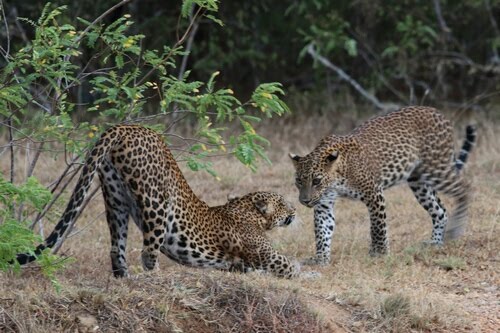 [This articles was first published in the Autumn 2016 Quarterly Newsletter of the UK-based Friends of Sri Lanka Association].
[This articles was first published in the Autumn 2016 Quarterly Newsletter of the UK-based Friends of Sri Lanka Association].On a visit to Sri Lanka in August 2016, I was an invited guest at Mahoora’s tented safari camp in Yala. It allowed me the opportunity to compare the two options for entry. The traditional entrance gate is via Kirinda and Palatupana. The larger tourist hotels by Jetwing and John Keells are just outside the buffer zone from the Palatupana gate. A large number of safari vehicles also arrive with guests from other hotels in the South-east, especially from Tissamaharama. On a diagonally opposite corner of the park, the route to the Katagamauwa entrance shares the public road to Sithulpahuwa, a well known Buddhist complex with a long cultural history and of archaeological interest. The accommodation that is presently available from Katagamuwa is mainly small guest houses and private bungalows, situated about half an hour’s drive from the national park entrance. Most of the properties which are permanent constructions (as opposed to being mobile) are not big enough to handle large tourist groups. Furthermore, most of them are not of a standard to be offered to tourists by the better known tour operators. The only facility that is presently available for large tour groups is the Mahoora tented campsite. Up to 70 tourists can be accommodated in luxury tents in what are actually two adjoining sites each accommodating around 30 plus tourists. Because the numbers are split between locations, and the tents are screened by thorn scrub it does not feels crowded. Mahoora has been operation for over a decade and is one of the pioneer tented safari camp operators. Their operation is well oiled with staff and facilities that emulates a tented safari experience modelled on offerings in East and South Africa. The tents have beds with fans and en-suite toilets. The meals were delicious with local produce and the presentation was good. Starters are followed by a main course and dessert with coffee or tea.
The camp service was good and mirrored
African tented safaris with a wake-up call. You had the option to a breakfast
pack on a safari. Most of the safari vehicles are booked by them through a
local safari vehicle operator. They do have two of their own vehicles.
Standards across the safari vehicles are fairly consistent with comfortable
forward facing seats. At the time of my visit, they had two naturalists in
residence who will need to be specially booked in advance. The Mahoora
experience is not cheap and the clientele is almost entirely foreign tourists
as many locals for that price prefer the hotels on the Palatupana entrance.
Mahoora is however not the most expensive either, as other tented camp operator
now provide air conditioned tents in an even higher price bracket.
 There have been a number of criticisms
raised recently that the park is over-crowded with safari vehicles. As the
person who led the publicity to brand Sri Lanka as a destination for Leopard safaris
and branding Yala (and more generally Sri Lanka) as a multi-day safari
destination, I continue to receive a lot of criticism. My view always has been
that the existing traffic can be managed and in fact substantially increased
without over-crowding by managing the entire Yala Protected Area complex of
1,500 square kilometres for conservation and tourism in a strategic way rather
than the present system of funnelling all visitors to Block 1 which is only 140
square kilometres. That is a topic I have discussed elsewhere. In this set of
field notes, I want to discuss the ‘Katagamuwa experience’.
There have been a number of criticisms
raised recently that the park is over-crowded with safari vehicles. As the
person who led the publicity to brand Sri Lanka as a destination for Leopard safaris
and branding Yala (and more generally Sri Lanka) as a multi-day safari
destination, I continue to receive a lot of criticism. My view always has been
that the existing traffic can be managed and in fact substantially increased
without over-crowding by managing the entire Yala Protected Area complex of
1,500 square kilometres for conservation and tourism in a strategic way rather
than the present system of funnelling all visitors to Block 1 which is only 140
square kilometres. That is a topic I have discussed elsewhere. In this set of
field notes, I want to discuss the ‘Katagamuwa experience’.
Useful
links

de Silva Wijeyeratne, G. (2016). Notes from the Field: Yala from the Katagamuwa Entrance. Friends of Sri Lanka Association (FOSLA). Autumn 2016 Quarterly Newsletter. Pages 9-10. Issued 2 October 2016.
Yala National Park from the Katagamuwa entrances and staying with Mahoora in their tented safari camp. Encounters with leopards and crocodiles.


